
The Boidae, commonly known as boas or boids, are a family of nonvenomous snakes primarily found in the Americas, as well as Africa, Europe, Asia, and some Pacific islands. Boas include some of the world's largest snakes, with the green anaconda of South America being the heaviest and second-longest snake known; in general, adults are medium to large in size, with females usually larger than the males. Six subfamilies comprising 15 genera and 54 species are currently recognized.

Chilabothrus exsul, the Abaco Island boa or Northern Bahamas boa, is a boa species found in the Bahamas. No subspecies are currently recognized. Like all other boas, it is not venomous.

Epicrates is a genus of non-venomous snakes in the subfamily Boinae of the family Boidae. The genus is native to South America and Central America. Five species are currently recognized as being valid, including the rainbow boa.

Corallus, the neotropical tree boas, are a genus of boas found in Central America, South America and the West Indies. Nine extant species are recognized as of 2017.

The green anaconda, also known as the giant anaconda, emerald anaconda, common anaconda, common water boa, or southern green anaconda, is a semi-aquatic boa species found in South America and the Caribbean island of Trinidad. It is the largest, heaviest and the second longest snake in the world, after the reticulated python. No subspecies are currently recognized. Like all boas, it is a non-venomous constrictor.

Corallus hortulana, previously known as Corallus hortulanus, and commonly known as the Amazon tree boa, common tree boa, garden tree boa, and macabrel, is a boa species found in South America. Previously, there were two recognized subspecies, Corallus hortulanus hortulanus, and Corallus hortulanus cooki, though the species has undergone taxonomic revision and has been broken up into several species. It is primarily nocturnal and arboreal, though it has been observed feeding and reproducing on the ground. Like all boas, it is non-venomous.

Candoia is a genus of non-venomous boas found mostly in New Guinea, Melanesia and the Maluku Islands in Indonesia. Common names include bevel-nosed boas and keel-scaled boas.

Corallus cropanii, or Cropani's tree boa, is a species of boa, a snake in the family Boidae. The species is endemic to the state of São Paulo, Brazil. Like all boas, it is not venomous. No subspecies are currently recognized. Until 2017, no specimen of this snake had been seen alive since 1953 and only five dead specimens had been collected since then, but in late January 2017, an adult female Cropan's tree boa measuring 1.7 m was captured by locals in Ribeira who brought it to herpetologists from the Instituto Butantan and the Museum of Zoology of the University of São Paulo, who radio-tagged and released the animal to learn more about the species' behavior.

The Cuban boa, also known as the Cuban tree boa and by locals as majá de Santa María, is a very large species of snake in the family Boidae. With lengths exceeding 5 m (16 ft) and a relatively heavy build, the Cuban boa is one of the largest snakes in the world. The species is native to Cuba and some nearby islands. No subspecies are currently recognized.

Eryx colubrinus, the Egyptian or Kenyan sand boa, is a species of snake in the family Boidae. The species is endemic to Northern and Eastern Africa. Three subspecies are recognized.

Boa imperator is a large and heavy-bodied arboreal species of nonvenomous, constrictor-type snake in the family Boidae. One of the most popular pet snakes in the world, B. imperator's native range is from Mexico through Central and South America, with local populations on several small Caribbean islands. It is commonly called the Central American boa, northern boa, Colombian boa, common boa and common northern boa.
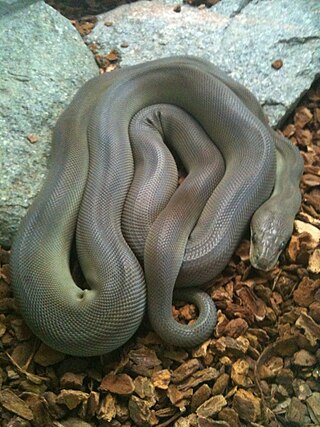
The olive python is a species of snake in the family Pythonidae. The species is endemic to Australia. Two subspecies are recognized, including the nominate subspecies described here.

Chilabothrus, commonly known as the Greater Antillean boas or West Indian boas, is a genus of nonvenomous snakes the family Boidae. The genus is endemic to the West Indies. 12 or 14 species are recognized as being valid.
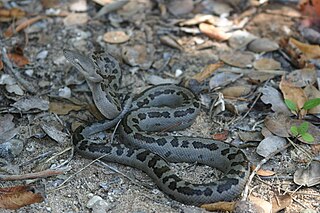
Chilabothrus chrysogaster, commonly known as the Turks and Caicos Islands boa or the Southern Bahamas boa, is a species of snake found in the Southern Bahamas and the Turks and Caicos Islands. Local names include the rainbow boa, the Bahamas cat boa, the rainbow snake, and the fowl snake. Like all boids, it is not a venomous species.
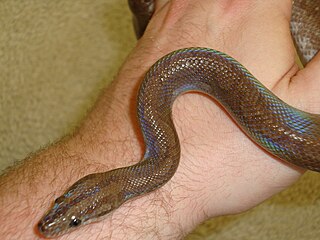
Epicrates maurus is a species of non-venomous constrictor in the family Boidae, commonly found in the Amazon region of South America. The common name for this species is the brown rainbow boa. This species is semi-arboreal, spending time both on the ground and climbing trees and shrubs, although they are also known to swim. They are nocturnal and primarily active in the middle of the night. Rainbow boas are known for their attractive iridescent sheen on their scales in the sunlight.
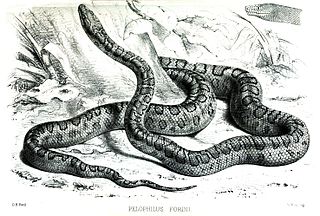
Chilabothrus fordii, also known commonly as Ford's boa and the Haitian ground boa, is a species of snake in the family Boidae. There are three recognized subspecies.
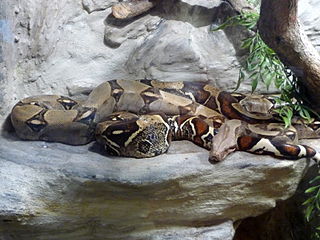
The boa constrictor, also known as the common boa, is a species of large, non-venomous, heavy-bodied snake that is frequently kept and bred in captivity. The boa constrictor is a member of the family Boidae. The species is native to tropical South America. A staple of private collections and public displays, its color pattern is highly variable yet distinctive. Four subspecies are recognized.
Chilabothrus granti, also known commonly as the Virgin Islands boa, is a species of snake in the family Boidae. The species is native to the Caribbean.

Chilabothrus strigilatus, also known commonly as the Bahamian boa, is a species of snake in the family Boidae. The species is endemic to the Bahamas. There are five recognized subspecies.




















